-
Publish Your Research/Review Articles in our High Quality Journal for just USD $99*+Taxes( *T&C Apply)
Offer Ends On
Neha*, G. Sirisha, N. Rajesh, Y. Greeshma Vani, G. Sindhuja and R. Saradha
Corresponding Author: Neha, MDS, Department of Periodontology, G.Pullareddy Dental College & Hospital, Kurnool, Andhra Pradesh, India.
Received: January 10, 2023 ; Revised: January 22, 2023 ; Accepted: January 25, 2023 ; Available Online: February 07, 2023
Citation: Neha, G Sirisha, N Rajesh, Y Greeshma Vani, G Sindhuja, et al. (2023) The Awareness of Oral Health and the Oral Hygiene Practices Followed and the Socio-Economic Status of People Visiting G Pulla Reddy Dental College and Hospital in Kurnool, Andhra Pradesh. J Oral Health Dent Res, 3(1): 1-10.
Copyrights: ©2023 Neha, G Sirisha, N Rajesh, Y Greeshma Vani, G Sindhuja, et al. This is an open-access article distributed under the terms of the Creative Commons Attribution License, which permits unrestricted use, distribution, and reproduction in any medium, provided the original author and source are credited.
Views & Citations
Likes & Shares
Objective: To assess the oral hygiene awareness, social status, economic status and brushing techniques and knowledge about dental visits of people living in Kurnool, Andhra Pradesh.
Study design and methodology: This is a cross sectional study, where a total of 1000 patients were randomly selected during their visit to G. Pulla reddy Dental College and hospital at Kurnool, and a predesigned structured questionnaire was given or read out, which included the education status, income, oral hygiene practice used and dental visit etc.,
Results: The statistical analysis using pie and bar diagrams showed that, most of the people belong to low economic status with family income less than 5000 per month, most of them completed schooling, they are aware about usage of tooth brush and tooth paste but unaware about type of brush to be used and brushing techniques, Gargling is done with water in maximum number of people after every meal and most of them visited a dental hospital only when they have severe to moderate tooth pain, knowledge regarding oral prophylaxis is limited.
Conclusion: People are conscious about maintenance of oral hygiene but method of brushing type of brush to be used, regular visit to dentist and oral prophylaxis should be guided to the patients and they should be educated about the importance of oral health for maintaining overall health by conducting camps and guiding programs not only in the hospitals but at various places like schools, colleges, working places and remote villages.
Keywords: Oral hygiene awareness, Socio economic status, Dental visits, Brushing techniques
INTRODUCTION
Plaque and calculus play a major role in the instigation of the gingival disease. Therefore, it’s a prerequisite to undertake plaque control measures like educate and motivate patients on oral hygiene awareness and maintenance. The quality of life, public awareness and individual perception is affected by Oral diseases. Gingivitis leading to inflammation of soft tissues surrounding the teeth can progress to Periodontitis leading to hard tissues destruction if not treated in the initial stages [1].
In the 1998 the theme for world health day was "Oral Health for Healthy life” [2].
Most of the studies emphasized that the main reason behind decreased importance to oral hygiene maintenance and importance of health care is paucity of awareness among the people [3].
To maintain an overall healthy life style along with regular exercise and yoga maintenance of perfect oral hygiene also plays pivotal role. The awareness of healthy oral cavity and stains and deposits free teeth highly anticipates on a person’s culture and socioeconomic status. Several oral care self-practices like varieties of tooth pastes, tooth brushes, mouth washes, flossing, provide an effective preventive measure at individual level for maintaining good oral health as a part of general health. Oral health knowledge is considered to be an essential prerequisite for health-related behavior [4]. But urban population and educated individuals with good socio-economic status are more conscious about their oral health when compared to uneducated individuals with low socioeconomic status. The prevalence of oral diseases is significantly higher among poor and disadvantaged population groups [5]. But, according to literature there are limited studies conducted about the oral hygiene status its maintenance and awareness of oral diseases among the population.
This study was conducted with the primary aim to evaluate,
MATERIALS AND METHODS
A cross sectional study was done and the patients visiting the outpatient department of G Pulla Reddy Dental college and hospital Kurnool district were randomly selected. A self-administered structured questionnaire including multiple choice questions were given to the patients between 18 to 65 years. of age in Local (Telugu) and English language. It was read out and filled by dental professional for patients who are uneducated. The questionnaire included,
Filled in questionnaire forms were collected and they were statistically analyzed using pie diagrams and bar tables to obtain the percentage results.
RESULTS
In the present cross sectional study patients were randomly selected and questionnaire forms were filled by them. Statistical analysis was done using pie diagrams and bar diagrams to calculate percentage results of different questions.
Socio demographic data
Table 1 depicts that, among the total number of patients 57% were males and 43% were females. The various parameters considered in questionnaires form are
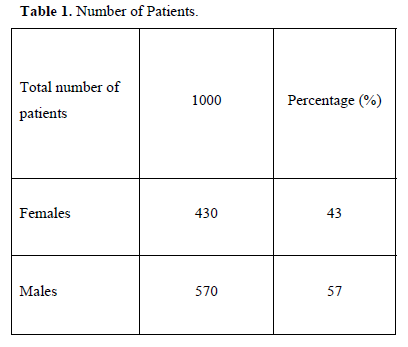
In Table 2, among the population 28% are uneducated without even basic education done, 40% went to school and studied till 6th class and above and 32% graduated (Graph 1). Most of the people completed their schooling.
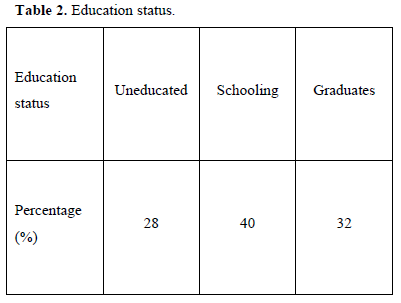

In Table 3, 46% of the people have total family income of less than 5000 rupees per month, 28% between 5,000-10,000, 13% between 10,000-20,000 and 13% above 20,000 a month (Graph 2). Most of the people have a family income below 5000 rupees.
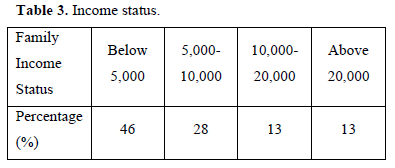
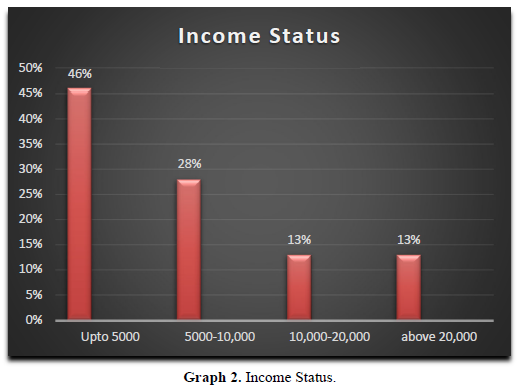
According to Table 4, 88% of the people used tooth paste, 5% used charcoal, 4% tooth powder, 3% neem stick as their tooth brushing material (Graph 3). Most of the patients are aware of using a tooth paste regularly for brushing their teeth.
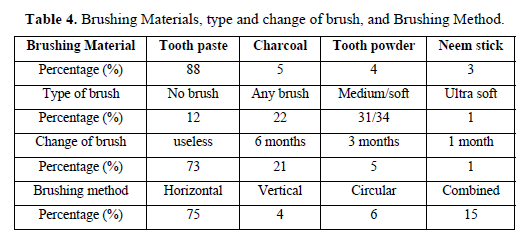

Among them 64% used any type of tooth brush, 21% used soft bristles tooth brush, 13% used no brush, 2% used ultra-soft brush (Graph 4). Maximum numbers of people are unaware about the hardness of the brush and type of brush they are using.

The frequency of changing brush among the individuals was 73% when brush becomes useless, 21% every 6 months, 5% every 3 months, 1% every month (Graph 5). Most of the people changed their brush only when the bristles are distorted.

75% of the people used horizontal type of brushing method, 15% combined, 6% circular, 4% vertical (Graph 6) Most patients are unaware about the tooth brushing method and used the routine Scrub technique to brush their teeth.

As per Table 5, 71% of the people gargle after every meal, 29% do not gargle (Graph 7). Most of the people have a habit of gargling with normal water after their meal. 82% gargle with water, Mouth wash used by 13%, oils by 5%.
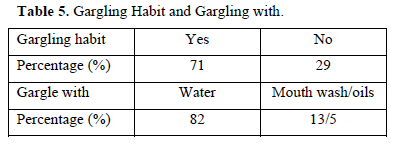

The knowledge of mouth wash is limited (Graph 8).

According to Table 6, 95% of the patients visit a dental hospital, only when there is tooth pain, 3% go for regular dental check up’s once in 3-6 months and 2 % once in a year. Dental visit due to: Tooth pain in 63% of the people, Restoration in 23%, 14% for Oral prophylaxis (Graphs 9 & 10) Most of the patients visit a dental hospital only in case of severe to moderate tooth pain. Awareness about regular dental visits and oral prophylaxis is less.
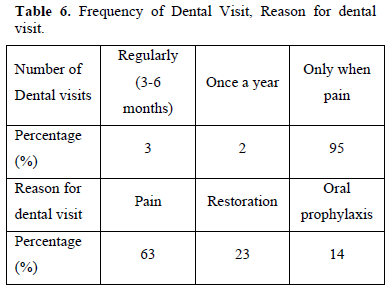


As per Table 7, among the patients 54% of the patients visited dental hospital previously whereas 46% visited for the first time (Graph 11).

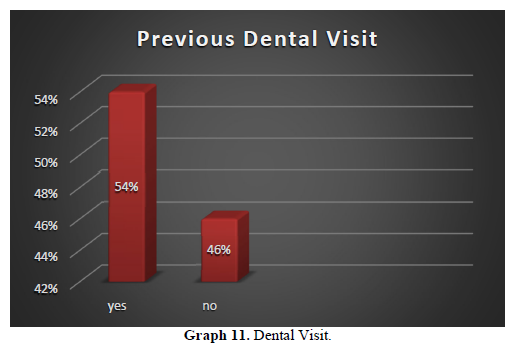
81% of the people brush their teeth once daily, 18% twice a day and 1% brushed occasionally (Graph 12). Mostly patient brush their teeth once daily, the importance and awareness about brushing the teeth twice is limited.

DISCUSSION
Over the past 3 decades diseases prevention is prioritized than the treatment aspect in any kind of disease. Maintenance of good oral health with regular teeth brushing, oral hygiene practices and regular dental visits are helpful in maintaining overall healthy personality. But people living in villages are unaware of many facts about the influence of oral health on overall health. Majority of disease shows their first signs and symptoms on oral cavity and remain unnoticed.
This study helped us to know that people living in Kurnool district are gaining knowledge about importance of regular brushing and regular dental visits.
According to the consumer usage and attitudes study done in 2010, among the most shocking of revelations is that nearly half of the Indian population does not use a tooth brush and only 51% brushed their teeth using a tooth brush and toothpaste [6]. But in our present study nearly 88% of people in Kurnool use tooth paste and tooth brush to brush their teeth and 81% brush their teeth once daily the people are aware about the importance of regular tooth brushing and its affects. Although people are using tooth brush but only 18% are brushing twice daily which is less compared to 58% of the Police recruits in a study by Dilip [7] 67% of the Chinese urban adolescents brushed their teeth twice daily and 48% students used fluoridated toothpaste. In a study by Jiang [8] and less than two thirds of the Kuwaiti adults brushed twice in a study by Al Shammari [9].
It is important to note that 75% of the population brushes their teeth horizontally, which causes harm to the tooth structure and the people have knowledge of using a tooth brush but are ignorant of type of brush (soft or Hard) to be used and also about the brushing techniques and 21% respondents used soft brush and these calculations are in agreement with a study conducted by Zhu [10] where 60% of the sample brushed by traditional horizontal method and 27% uses soft brush.
According to this study, Major percent 63% of the patient undergo dental visit due to tooth pain which is in contrast to a study by Gilbert [11] and Buhlin [12] who showed that self-reported bleeding gums was high in percentage. And in accordance with a study done by Nabil Al-Beiruti, where 69.5% of the participants reported visiting a dentist only when they have pain [13].
This study showed that 71% of the patient gargles after having meals, but according to a study by Nitika Jain, [14] only 29% of the population rinses their teeth after meals. People are acquainted with gargling using normal water the usage of mouth wash is very rare.
A study done by Veena Bhasin among Bhils, a tribal community of Rajasthan, India, was approximately 90% of the population was illiterate, shows very less preventive oral knowledge and behavior [15] but in our study only 29% of the people are illiterate and are having good knowledge about oral health. Most of the people have done their schooling.
A study done by Kaye F. Roberts-Thomson and A. John Spence [16] in South Australia, 87% 0f respondents go for regular dental visits, and study by Padma K Bhat [17] where 19% respondents went for regular dental visits. But in our study only 5% of the patients go for regular dental visits once or twice in a year which is very less compared to other studies. People are negligent about regular dental visits and have no apprehension about visiting a dentist regularly.
There are few limitations in the present study where in, only the patient visiting the dental hospitals are evaluated but a much larger population can be considered by conducting various camps in different areas, schools, colleges and offices. The monthly income status of the patient’s family is considered but the number of people in the family is not taken into account. Tooth pain is considered as the main reason for dental visit but the reason for the tooth pain whether carious tooth or abscess or fractured tooth is not focused upon.
So, many more such studies should be conducted on large basis to increase the awareness among the people. And educate the patient about the importance of Oral hygiene maintenance and regular change of tooth brush and brushing techniques, type of brush to be used. Importance of gargling and regular dental visits and brushing teeth twice daily.
CONCLUSION
In conclusion, it can be said Most of the people are ready to learn and also aware of the importance of oral hygiene and its effects on overall health. As most of the people are aware of using a tooth brush but type of brush to use and brushing techniques should be thrower light upon. Education programs will be helpful not only in colleges and hospitals but various areas at school level, college level and village level to gather maximum number of population and teach them the simple basic things such as brushing techniques, type of brush to use and flossing, gargling.
We, as dentists, will have to keep reinforcing the importance of correcting all aspects related with brushing and flossing and number of times to brush the teeth along with the importance of regular dental checkups. The education status and the income status play a major role. So people should be motivated to educate themselves and their children for the wellbeing and a healthy society.
The task of spreading this awareness extends beyond our clinic and colleges to general masses and it will have to be achieved in a similar way by various outreach programs and relevant public health awareness measures through various mediums like televisions, radio programs, and regular dental camps in villages to spread the awareness.
Because a healthy mouth leads to healthy body and further to a healthy village and healthy country.
No Files Found
Share Your Publication :